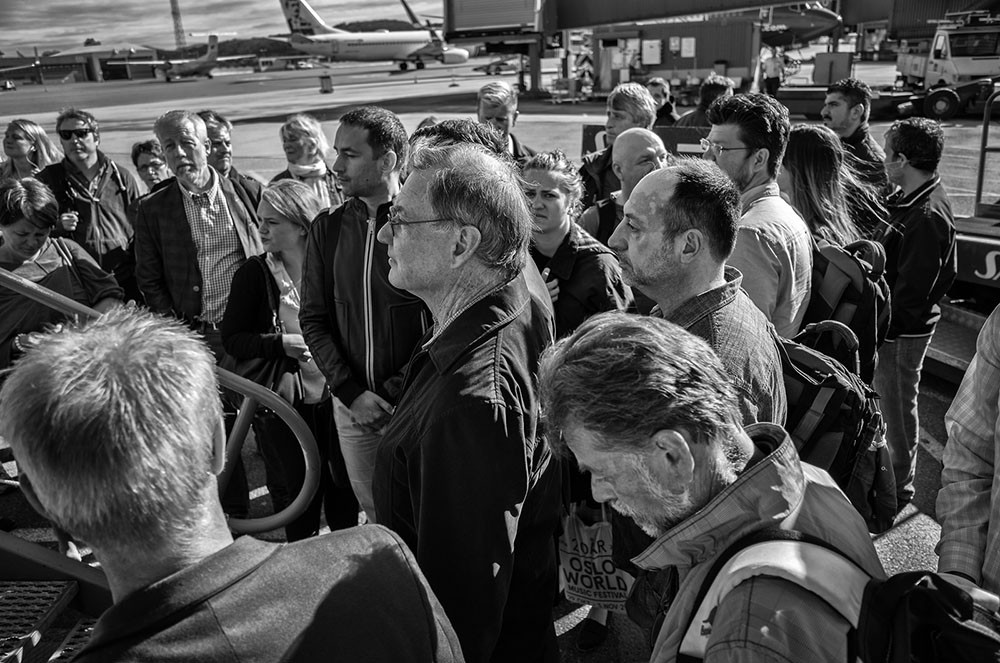
©Anne Worner, 2014. Travelers gather on the tarmac after an evacuation of Flesland Airport in Norway.
Lately, all it takes to create an active shooter scenario is a few loud noises and a crowd conditioned to expect mass killings. No gunman required.
That was the case recently at the Los Angeles International Airport, where a series of events including loud noises and a man dressed as Zorro led airport goers to self-evacuate in a willy-nilly fashion. Two weeks earlier, a similar situation occurred at John F. Kennedy International Airport in New York. In the same time period (August 13-28), at least four malls across the nation also saw crowds fleeing imaginary gunmen.
While emergency responders and safety officials are much better prepared to respond to acts of terrorism and mass violence since the 9/11 terrorist attacks, the recent spate of incidents show that the public is also much better prepared—to panic.
“Plausibility is the enemy here,” Brian Jenkins, a security and terrorism expert at Rand, told the Los Angeles Times. “The perception is that it’s real. At that point, anything can reinforce that perception.
Reports from the multiple incidents show that to be the case. In each event, loud unidentified noises caused a group of people to run, and that running snowballed into a panicked mass exodus.
Francisco Levane, a shopper at Florida Mall, told the Orlando Sentinel that after the Pulse nightclub shooting, he was primed to believe that the popping balloons that sparked a panic there on August 25 was a credible threat.
"I lost two friends at Pulse, so of course that was my first thought," he said.
Social media can also escalate such situations. At LAX, tweets and posts of videos showing the hysteria allowed it to spread far beyond the terminal where it began—and that in turn hampered response. Not only could security officials not locate the threat, they couldn’t adequately assess the situation in each location.
“There’s rapid dissemination of information on social media that’s not being filtered by anybody,” Roxane Cohen Silver, a professor of psychology and social behavior at the University of California, Irvine, told the New York Times. “This provides the unfortunate opportunity for rumors to be transmitted very quickly, without any ability to evaluate the veracity.”
Official communication using the same media as the frightened crowds can help quell misinformation, but—at least in the case of LAX—it came too late. There, crowds that had self-evacuated onto the tarmac had already returned to the building by the time the official messages were sent, according to the Times.
Gary Small, a UCLA professor of psychiatry and behavioral science, experienced a similar situation—but a much different response—at the Charles de Gaulle airport in Paris in June. Even considering Parisian's heightened awareness of terrorism, crowds calmly evacuated as police detonated a suspicious abandoned suitcase.
While responders in that case were dealing with a known threat, Small—who also happened to be present at the JFK incident—chalked the difference up to a swift and decisive direction given by security guards.
“My guess is that we can expect to observe more of [panic] episodes,” Small wrote in STAT. “Such attentiveness has saved many lives since 9/11. Thanks to almost daily reports of terrorist attacks, we’re told to be ever more vigilant of anything suspicious or out of the ordinary. But at the same time we need more effective ways of stopping the spread of rumors and false beliefs of imminent threats.”
Considering the recency of the events, there’s been little information in terms of what might have been done better during any of the incidents. A report examining a deadly 2013 shooting at LAX, however, found that a lack of information from official sources contributed to the chaotic evacuation and general unease.
“The biggest failure was the lack of communication,” Mayor Eric Garcetti said in a March 2014 news conference after the report was released. “People were with no information by and large for too many hours and that was unacceptable.”
There have been calls for a new examination to assess measures implemented since the 2013 incident, and a pilot program to train airport workers to assist in emergency is also in the works. Still, the response at both LAX and JFK show a glaring inability to respond to potential threats at our nation's airports.
“Officials were slow to respond and seemed confused or even ignorant of security protocols, and there were reports of TSA agents abandoning their posts,” wrote the Editorial Board of the New York Times about the JFK scare. “There was no obvious chain of command, and no coordination among the responsible agencies—all of which was deeply alarming, given the terrorist attacks this year at airports in Brussels and Istanbul.”
A federal review of that event has also been requested, but if the chilling firsthand account by New York Magazine writer David Wallace Wells is any indication, these occurrences will only lead to more fear and fearful crowds.
Wells pointed out that the fact that the mayhem stemmed from the mere perception of an attack made it all the more unsettling, especially in place where security standards are supposed to be top-notch.
“Within minutes, the whole apparatus of the airport and its crowd-control mechanisms had collapsed into total disarray,” he wrote. “When the thousands of us who had been racing away from shooters finally managed to catch our breath, long after midnight, the idea that the airport could ever manage a crowd, let alone a hysterical one, looked ridiculous.”
Jolie Breeden is the lead editor and science communicator for Natural Hazards Center publications. She writes and edits for Research Counts; the Quick Response, Mitigation Matters, Public Health, and Weather Ready Research Award report series; as well as for special projects and publications. Breeden graduated summa cum laude from the University of Colorado Boulder with a bachelor’s degree in journalism.